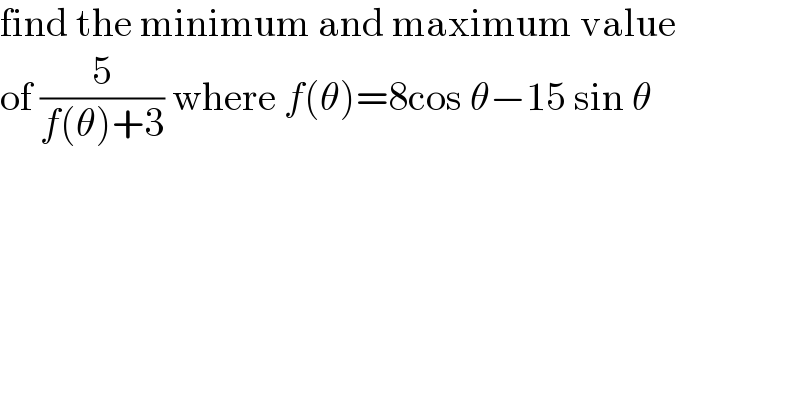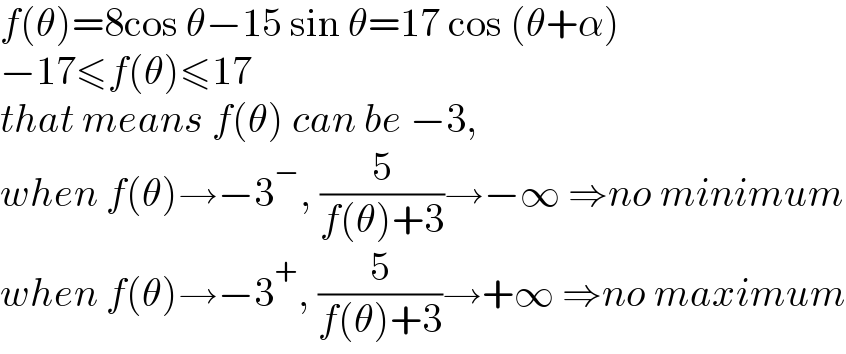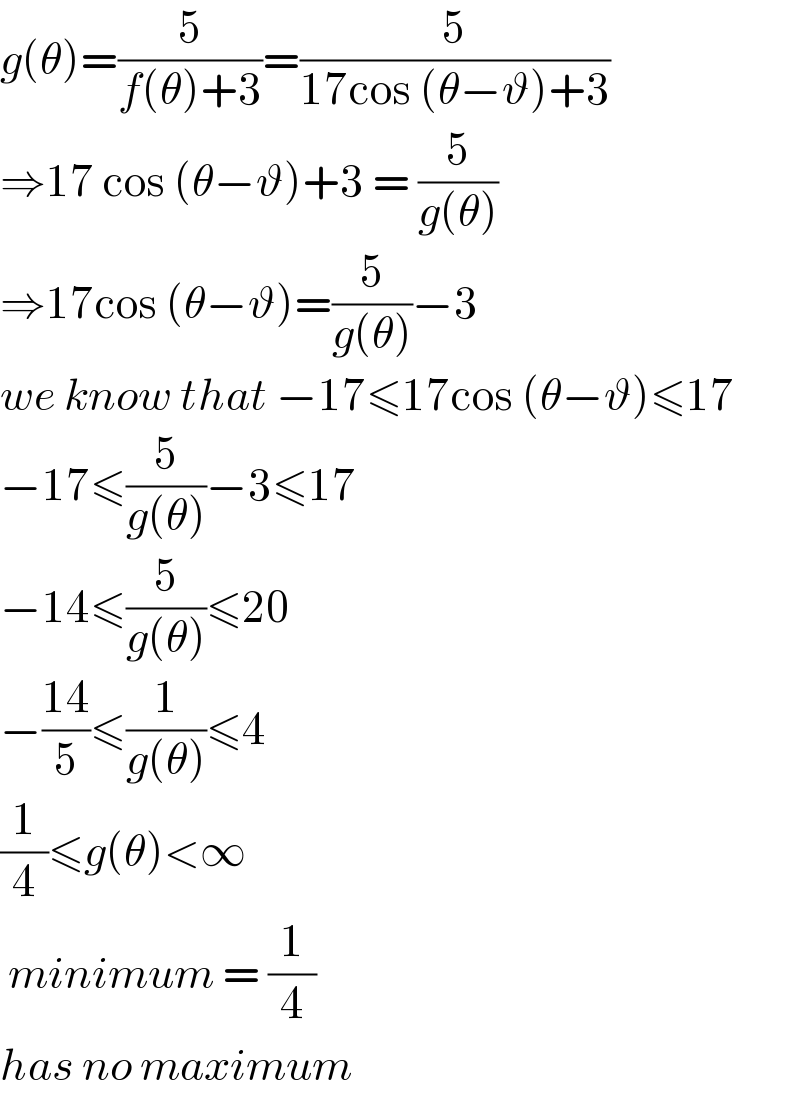
Question Number 153870 by physicstutes last updated on 11/Sep/21

$$\mathrm{find}\:\mathrm{the}\:\mathrm{minimum}\:\mathrm{and}\:\mathrm{maximum}\:\mathrm{value} \\ $$$$\mathrm{of}\:\frac{\mathrm{5}}{{f}\left(\theta\right)+\mathrm{3}}\:\mathrm{where}\:{f}\left(\theta\right)=\mathrm{8cos}\:\theta−\mathrm{15}\:\mathrm{sin}\:\theta \\ $$
Commented by mr W last updated on 12/Sep/21

$${there}\:{are}\:{no}\:{minimum}\:{and}\:{no} \\ $$$${maximum}.\:{there}\:{are}\:{only}\:{local}\: \\ $$$${minimum}\:{and}\:{local}\:{maximum}. \\ $$
Commented by physicstutes last updated on 12/Sep/21
why sir?
Commented by mr W last updated on 12/Sep/21

$${f}\left(\theta\right)=\mathrm{8cos}\:\theta−\mathrm{15}\:\mathrm{sin}\:\theta=\mathrm{17}\:\mathrm{cos}\:\left(\theta+\alpha\right) \\ $$$$−\mathrm{17}\leqslant{f}\left(\theta\right)\leqslant\mathrm{17} \\ $$$${that}\:{means}\:{f}\left(\theta\right)\:{can}\:{be}\:−\mathrm{3}, \\ $$$${when}\:{f}\left(\theta\right)\rightarrow−\mathrm{3}^{−} ,\:\frac{\mathrm{5}}{{f}\left(\theta\right)+\mathrm{3}}\rightarrow−\infty\:\Rightarrow{no}\:{minimum} \\ $$$${when}\:{f}\left(\theta\right)\rightarrow−\mathrm{3}^{+} ,\:\frac{\mathrm{5}}{{f}\left(\theta\right)+\mathrm{3}}\rightarrow+\infty\:\Rightarrow{no}\:{maximum} \\ $$
Answered by liberty last updated on 11/Sep/21

$${g}\left(\theta\right)=\frac{\mathrm{5}}{{f}\left(\theta\right)+\mathrm{3}}=\frac{\mathrm{5}}{\mathrm{17cos}\:\left(\theta−\vartheta\right)+\mathrm{3}} \\ $$$$\Rightarrow\mathrm{17}\:\mathrm{cos}\:\left(\theta−\vartheta\right)+\mathrm{3}\:=\:\frac{\mathrm{5}}{{g}\left(\theta\right)} \\ $$$$\Rightarrow\mathrm{17cos}\:\left(\theta−\vartheta\right)=\frac{\mathrm{5}}{{g}\left(\theta\right)}−\mathrm{3} \\ $$$${we}\:{know}\:{that}\:−\mathrm{17}\leqslant\mathrm{17cos}\:\left(\theta−\vartheta\right)\leqslant\mathrm{17} \\ $$$$−\mathrm{17}\leqslant\frac{\mathrm{5}}{{g}\left(\theta\right)}−\mathrm{3}\leqslant\mathrm{17} \\ $$$$−\mathrm{14}\leqslant\frac{\mathrm{5}}{{g}\left(\theta\right)}\leqslant\mathrm{20} \\ $$$$−\frac{\mathrm{14}}{\mathrm{5}}\leqslant\frac{\mathrm{1}}{{g}\left(\theta\right)}\leqslant\mathrm{4} \\ $$$$\frac{\mathrm{1}}{\mathrm{4}}\leqslant{g}\left(\theta\right)<\infty \\ $$$$\:{minimum}\:=\:\frac{\mathrm{1}}{\mathrm{4}} \\ $$$${has}\:{no}\:{maximum} \\ $$
